Mars Models 1/48 Lavochkin La-15
The Airplane:
The Lavochkin La-15 is proof of the truth of the John Clark Rule (Clark is Tom Clancy's go-to character for “getting things done” for those who don't get the reference): “Good enough is good enough, and perfect is a pain in the assets.”
The La-15 was Semyon Lavochkin's answer to the same design request that produced the MiG-15. One can see looking at it that old Semyon had diligently gone through Kurt Tank's file folders on the Ta-183. Using a better engine, which allowed a longer fuselage, he came up with the result Tank aspired to.
While the two airplanes prove that different designers working to answer the same set of questions will come up with similar results, the La-15 was actually very much unlike its competitor.
For one thing, rather than using the British Nene jet engine for power, the La-15 used the Derwent, which was the other jet engine that the British sold production rights to the Soviets in 1947.
The reverse-engineered Derwent engine, named the Klimov RD-500, produced 3,600 pounds of thrust, less than the Nene, which resulted in a smaller, lighter airplane in order to obtain similar performance. This resulted in the La-15 being superior to the MiG-15 in fighter-vs-fighter combat, but the requirement was for an airplane that could climb to 50,000 feet and blow the wing off a B-36. This the La-15 couldn't do, since its armament was three NS-23 23mm cannon, without the MiG's 37mm monster. Also, its maximum operational ceiling was 44,000 feet, not 50,000 feet, which the MiG was capable of.
Additionally, the MiG-15 emerged in prototype form quite close to the first production version, while the La-15 needed further development.
The La-15 first flew on January 8, 1948, under the prototype name Aircraft 174; this was just nine days after its counterpart the Mikoyan-Gurevich I-310. Compared to Lavochkin's previous attempts, the La-152 and La-160, which used German engines, the La-15 was like the MiG-15 in that it looked completely different from what had come before. The first prototype was however lost on May 11, 1948 due to vibration. Trials were continued with an improved second prototype, designated Aircraft 174D, which underwent State Acceptance Tests from August to September 25, 1948. In comparison with the Nene-powered MiG-15 it had almost the same maximum speed and better maneuverability, with somewhat reduced rate of climb. One airframe was even fitted with the Nene and flew as the La-168. Allegedly, this was the first Soviet airframe to exceed Mach 1 in a dive, but the collapse of the canopy once past the Mach 1 pressure barrier led to the unfortunate death of the pilot.
In tests, the La-15 flew better than the MiG-15, being overall lighter. It had excellent maneuverability; most prominently, it could stay in a high-G turn for more than 40 degrees without the likelihood of “swapping ends,” a common event with the MiG-15 in that maneuver. However, its lighter structure was not as sturdy as the MiG-15, which could take all the .50 caliber hits a Sabre could throw at it, so long as there wasn't a “golden bb” among them that hit one of the few vital spots (This is why USAF claims of MiG-15s shot down are largely well-meaning, sincere, fantasy - from the first one claimed onward). There is mention of the La-15 being “combat tested.” If it was, the Sabre pilots who met it didn't recognize that it wasn't some kind of MiG-15.
Production began in 1950 and 235 La-15s were produced, seeing limited operational use. All were assembled at the Plant 21 "Sokol" design bureau production facility in the city of Nizhny Novgorod in Western Russia. They were withdrawn from service by 1953, though they served long enough to get the NATO reporting name of “Fantail.”
The La-15 was popular with pilots because of its easy handling and reliability, and its pressurized cockpit was an advantage at high altitude. Nevertheless, official enthusiasm for the La-15 was mild, largely because it was a complex design that required complicated and expensive production tooling, unlike its competitor.
In the end, slightly better flight performance on the part of the La-15 was not enough to make the sheer ease of manufacturing and durability of the MiG-15. “Good enough is good enough, and perfect is a pain in the assets.”
Only 235 La-15s were built, serving with the Soviet Air Force until 1953.
Maximum speed was 626 mph at 26,350ft, with a range of 711 at 32,810ft. Service ceiling was 44,300 ft with a rate of climb of 6,240 ft/min, reaching 32,180ft in 9min.
The kit:
This 1/48 kit from Mars Models, which was released to little publicity this past October (I only found it by chance while looking for something else on eBay), can safely be filed under A Model Of An Airplane I Never Thought I Would See.
That I am aware of, there is a previous La-15 from Cooperativa in 1/72 which is an “old” (i.e., clunky kit design) limited-run kit that has nice surface detail and a cockpit canopy with the clarity of a Coke bottle.
This kit looks like a new Sword limited-run kit. The kit design is overall simple and effective, with good fit except for the upper forward fuselage part that goes over the cockpit and intake, which I think is the result of the interior parts there being a very tight fit. The canopy is very clear and can be posed open. Decals are provided for a total of ten different airplanes by Bort Numbers, all in basic NMF with color differences by unit.
The result appears accurate in dimensions and detail.
Construction:
The fuselage is divided fore and aft. I glued the separate fuselage halves together before proceeding with further assembly.
The kit includes the intake tunnels to either side of the cockit, full length. Since I think these parts are what makes the forward fuselage problematic when assembling the final exterior part if I was doing this again I would sand down the outer part to about half its thickness, leaving the inner half the forms the cockpit sidewalls alone.
The cockpit is basic, but detailed enough. I painted it “steel grey” (a color very close to US Neutral Gray) and proceeded to assemble the gear wells and exhaust.
I assembled the fuselage without the part that covers the cockpit, then assembled the wing and attached it, then the vertical fin and horizontal stabilizers. I was able to stuff sufficient flattened fish weights into the area ahead of and immediately behind the cockpit to get a nose-sitter. I then attached the upper forward fuselage part, which required no less than four rubber bands wrapped tightly around the area to get it to close up with the rest. This was the only area where I had to apply any significant amount of filler to get everything smooth.
You can see construction in-progress shots in the "In Progress" group here.
Painting and Decals:
I decided to do one of the airplanes flown by the operational test unit at Kubinka, with a colorful scalloped red forward fuselage, which I then masked off. I painted the rest of the model wth Tamiya X-18 semi-gloss black then misted on Vallejo “Aluminum.”
I used the blue Bort Number to insure that the red wouldn't bleed through from underneath. I did test later and find that the white decals are opaque enough to use. The decals all went down without problem. There are some tiny in-scale stencils that are almost invisible when applied, which I decided to skip.
Final Assembly:
The stalky landing gear is fragile in its design, and I ended up assembling the main gear legs using CA glue for strength.
Overall:
This is a very nice kit from Mars Models that makes up into a good model of a little-known airplane that finished Lavochkin's business as a fighter design bureau. It proves that “better” isn't always better. On the basis of this kit, I am looking forward to the release of their MiG-9. Recommended for those with experience with limited-run kits.
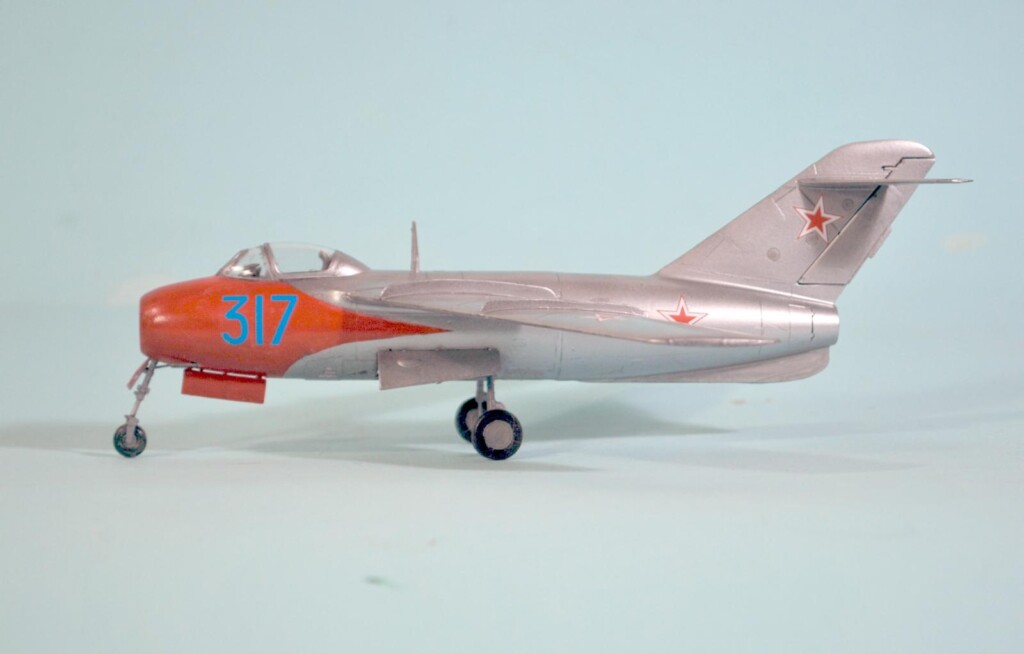
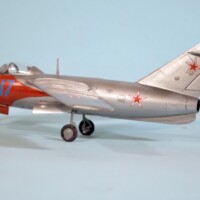
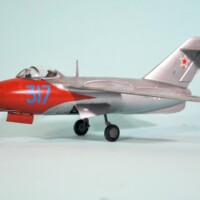
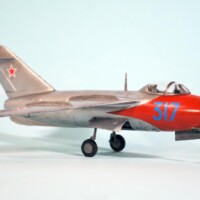
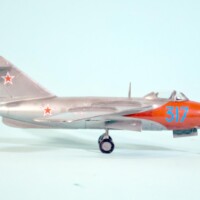
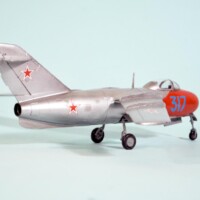
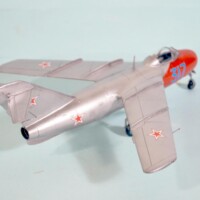
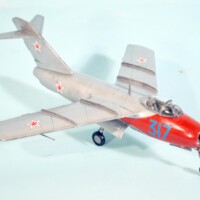
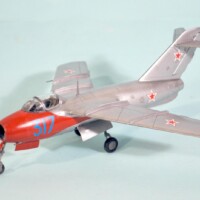
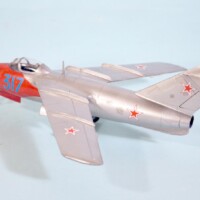

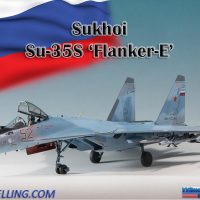
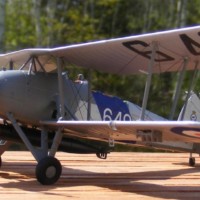

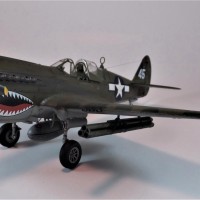
Swoopy Russian '50s fighter...what's not to like?!? Cool seeing one built; very nice article and model @tcinla!
What a great name for a character.
I actually Laughed Out Loud.
I have all of Clancey’s books and Without Remorse is one of my favorites. Beware the wrath of a patient man.
Nice result, Tom.
After a hard day of battle looks like you better have your wits about you to land on that delicate landing gear.
Great looking build of a not so common aircraft, Tom.
Definitely see the German influence, and I still can't get my head around how the Soviets got to buy the engine technology.
It was 1947, the Cold War was visible on the horizon, but not here, and perhaps there was a way to get back to the wartime relationship of at least being non-competitors. It was more of a chance than many would have taken, but the memory of how awful the last two had been (these decision makers were people who had been there for both WW1 and WW2) could breed a thought that perhaps a daring move might lead to a good end. Hindsight is always 20/10
Really nice, Tom (@tcinla). You really did a lot of extra work to make this one look this good. I had never heard of this plane when I saw your WIP. It is a very interesting plane that never made the big times. Thanks for the great story about the development of this plane. I bet that a canopy coming apart at Mach 1 would probably ruin your day. I had a windscreen shatter in a C-141 at 39,000 feet that really got my attention. Luckily our windscreens were made of multiple layers of various materials, and it was only the outer layer that shatters. It still ruined a perfectly good flight suit. It looks like our Russian friend wasn't so lucky.
Great result on a great find, Tom. I love stuff like this.
Nicely done, and something unusual, Lavochkin was right about the high wing.
He was.
Amazing model and great story of an obscure but important plane, Tom!
Very nice build of this early jet age aircraft, Tom @tcinla
I was not even aware of the existance of this aircraft, but after reading your article, I'm definitely going to do some more reading about it.
Excellent build and history Tom. Thank you for sharing the model and the story line.
@tcinla, Tom, wasn't the Yak-30 also a result of that same design request that resulted in the MiG-15? While reading your article, I kept thinking there was a third offering that also resembled the La-15 and MiG-15. Sure enough, I found the reference in my well-thumbed Rand McNally Encyclopedia of Military Aircraft by Enzo Angelucci. Here's bit from miitaryfactory.com:
https://www.militaryfactory.com/aircraft/detail.php?aircraft_id=1272
I wonder if a scale model of that was ever produced?
A good looking Cold War Warrior - well done! (ok - maybe "warrior is a stretch, but at least the alliteration works!)